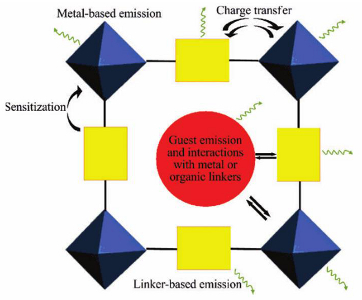Elucidating the luminescence properties of functionalized UiO-66 frameworks via Theory
Elucidating the luminescence properties of functionalized UiO-66 frameworks via Theory
Promotor(en): K. Hemelsoet, V. Van Speybroeck /15_SPEC04 / SpectroscopyMetal-Organic frameworks (MOFs) are porous, crystalline materials, built out of inorganic clusters, connected by organic linkers (see Figure 1). Due to their unique structure, they exhibit properties similar to solids and others related to molecular systems. The large amount of building bricks available allows tuning of the MOF material for a specific application, making them interesting candidates for catalysis, gas sorption, biomedical and recently also photocatalysis and luminescence applications. The latter two applications require insight in the excited state behaviour of these complex materials, since they directly involve transitions between an excited state and the ground state. These electronic transitions determine the optical properties and at this point, the methodological development to investigate these optical characteristics of the complex MOF materials using theoretical simulations is still at its infancy. The challenge is to describe the excited states, which is typically done with advanced many-particle methods. For very large systems (such as MOFs), time-dependent density functional theory is the only applicable technique, due to its computational efficiency. The aim of this master thesis research is hence to advance in this theoretical description and to develop and apply new tools modelling the excited-state properties of these realistic advanced materials. These developments are urgently needed to accompany the available experimental data, which cannot fully be unravelled without additional theoretical input.

Figure 1: Schematic representation of luminescence phenomena in MOF frameworks. Adapted from [Allendorf et al., Chem. Soc. Rev. 38 (2009) 1330]One promising material is the UiO-66 MOF, consisting of zirconium nodes connected by terephthalic linkers. This material has a high stability in different environments and a very active catalytic centre thanks to linker defects in the framework, creating open metal sites. A recent study in our group showed that the light absorption properties of the framework can be tuned very precisely by adding different functional groups to the linkers. This opens interesting possibilities for tailor-made luminescence and photocatalysis applications. Since the linkers are tightly connected with the metal nodes, transfer of energy is possible between these subsystems.
We will focus on ab initio techniques, and in particular on TD-DFT, to compute directly the electronic transitions and intensities. TD-DFT has witnessed a lot of progress is recent years and it can be applied for molecular systems of large size. The main challenge is to include the periodic nanoporous environment in the simulations.
Aim This thesis will investigate the luminescent properties of MOFs, using the functionalized UiO-66 as a test system. The aim is the development, implementation and application of new theoretical tools modelling the excited-state properties. Initial calculations on the subsystems (metal node and linker) will be compared with cluster and periodic calculations, in order to gain deeper insight in all the processes occurring in these frameworks. The latter calculations require new implementations in existing periodic software codes. This challenging aspect requires an analytical mind to gain insight in the underlying theoretical framework for computing excited-state properties and some programming skills. It is not necessary to have experience with molecular modelling; this will be learned during the thesis research. There will be a close interaction and good coaching with other researchers working on this topic, and depending on the specific interests of the interested student, particular items can be selected for this master thesis research. For example, the focus can lie on the methodological development and implementations, or on the applications.
- Study programmeMaster of Science in Engineering Physics [EMPHYS], Master of Science in Physics and Astronomy [CMFYST]ClustersFor Engineering Physics students, this thesis is closely related to the cluster(s) (1) Modelling, (2) Photonics, (3) FundamentalsKeywordsElectronic structure methods, Spectroscopy, Metal-organic frameworks, Optical propertiesRecommended coursesSimulations and modeling for the nanoscale; Veeldeeltjesfysica

